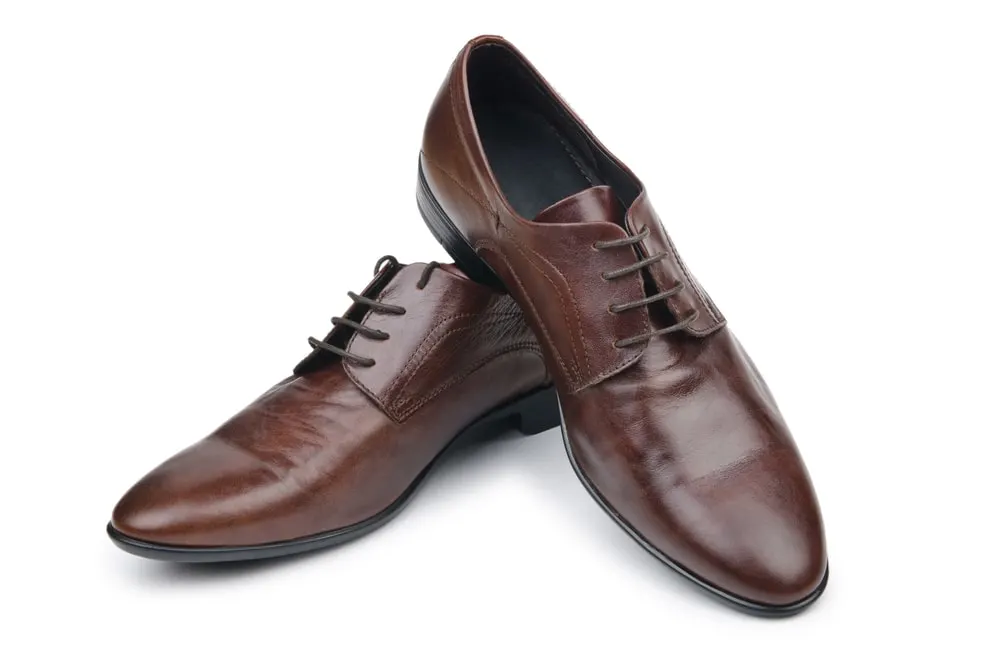Simple, light and neutral suit colors such as grey are versatile, especially when paired with a blue shirt. But the combination needs to be worn in the right setting and in the right way for it to work.
Here’s the bottom line:
A light grey suit can be worn with a blue shirt in both business-professional and smart-casual settings. Light blue shirts would be the better option in professional settings, while shirts in medium and dark shades of blue can be considered in more casual environments.
While that’s the gist, there’s plenty more to it when you’re aiming for perfection.
Let’s go through some tips for elevating this combination to new and unimaginable heights.
An exaggeration? I’ll let you decide.
Enjoy.

7 Tips For Wearing A Light Grey Suit With A Blue Shirt
Whatever style of light grey suit and blue shirt you may be thinking of wearing, it’s very likely that one or two of these tips will make all the difference for you.
So, be sure to read them all.
Check The Dress Code
A light grey suit and blue shirt combination is most suitable in business-professional and smart-casual settings.
Avoid the combination in truly “formal” settings. These are settings where dark and neutral suits (eg. charcoal, black, and navy) reign supreme, and a light grey suit usually wouldn’t cut it.
Also, avoid the combination in business-casual settings.
While opinions vary on this, in general, suits should be avoided altogether in business-casual environments.
Dress pants/chinos + OCBD/dress shirt combinations would be much more appropriate.
In business-professional settings, a light grey suit and light blue shirt combo would usually be appropriate, but not always.
It depends on what’s considered the “norm” at the specific workplace we’re talking about. In some, you’d be much better off sticking to dark and neutral suits.
In others, a light grey suit would usually be considered acceptable.
In smart-casual settings, a light grey suit and blue shirt combination would be absolutely fine.
Consider The Shade Of Blue
When wearing a light grey suit in a business-professional setting, a light blue shirt should always be worn. In smart-casual settings, you could consider wearing a medium or dark blue shirt as an alternative.
A light blue shirt (eg. baby, sky, or powder blue) has a naturally professional aesthetic to it.
It’s considered acceptable in most workplaces, along with the more traditional white shirt and the more eye-catching light pink shirt.
Avoid wearing shirts in medium and dark shades of blue in professional settings. It would always be considered underdressing and inappropriate.
In smart-casual settings, you can wear a light grey suit with medium or dark blue shirts if you want a high-contrast and eye-catching combination.
The darker the shade of the blue shirt, the higher the level of contrast and the more attention-grabbing the combination is likely to come across.
It can work, but only in casual settings.

If you’d prefer a more subtle aesthetic, even in smart-casual settings, go for a light blue shirt instead.
Here’s a table summarizing some common shades of blue, together with the dress codes they’d be most suitable for when wearing a light grey suit.
| Light Grey Suit And A Light Blue Shirt | Business-Professional Or Smart-Casual |
| Light Grey Suit And A Baby Blue Shirt | Business-Professional Or Smart-Casual |
| Light Grey Suit And A Sky Blue Shirt | Business-Professional Or Smart-Casual |
| Light Grey Suit And A Royal Blue Shirt | Smart-Casual |
| Light Grey Suit And A Navy Blue Shirt | Smart-Casual |
| Light Grey Suit And A Dark Blue Shirt | Smart-Casual |
Consider The Fabrics And Weaves Of Each Item
A light grey suit and blue shirt combination can look very different depending on the fabrics and weaves of each of these items.
Here’s the main takeaway point:
- Smoother and less wrinkly fabrics are more appropriate in business-professional settings.
- Rough, rugged, and wrinkly fabrics/weaves are more appropriate in smart-casual settings.
In a business-professional setting, consider a structured light grey suit with a smooth, shiny texture. Worsted wool should do it.
In addition, consider a light blue dress shirt made from a tightly woven cotton fabric. Poplin and Oxford weaves work well.
In smart-casual settings, the light grey suit can be made using a more relaxed and rugged fabric or weave.
Tweed, herringbone, serge, flannel, linen; you’ve got plenty of options here.

“Casual” light grey suits will also usually have less structure, with less padding at the shoulders and less tapering at the waist.
The same principles should be applied to the blue shirt.
Rougher and more rugged shirt fabrics you could consider include Oxford cloth, linen, and chambray.
Choose The Perfect Tie Color
When wearing a light grey suit with a blue shirt in a professional setting, you’ll most likely need to pair it with a tie.
If you’d prefer a more subtle aesthetic here, consider a tie in a dark shade of blue (eg. navy) or a dark shade of grey (eg. charcoal).

You can rest assured it’ll coordinate seamlessly given how neutral they are. But they’ll also form a noticeable monochromatic pairing with either the suit or the shirt.
If you’d prefer to add a splash of color to the outfit, consider a tie in a similarly “cool” color.
Let me explain.
Both the light blue shirt and the light grey suit have noticeably “cool” undertones.
While you could add some contrast by going for a “warm” colored tie, going for a similarly “cool” colored tie is a more easy-going and subtle approach.
For example, consider a forest green or plum purple tie. They’re bold, but also dark, muted, and “cool”.
They’re also generally fine to wear in the workplace.
When wearing a light grey suit and a blue shirt in a smart-casual setting, ask yourself whether a tie is really necessary in the first place.
You’ll often find that it’s either unnecessary or may even be considered overdressing for the occasion.
The Shoe Color Should Suit The Setting
Both brown and black shoes work well when wearing a light grey suit with a blue shirt. The setting should guide the choice, with dark brown and black shoes being preferable in dressier and more professional settings.
Shoes in lighter shades of brown such as tan do work well in smart-casual settings, as do oxblood and burgundy.

Generally, however, these bolder colors wouldn’t usually be advisable in professional settings. Oxblood might be, as it’s quite similar to dark brown.
But burgundy shoes have more of a social look and feel to them, rather than professional.
When wearing a casual blue button-up with a casual light grey suit, you do have the option of going even more casual with your choice of footwear if you wanted to.
In other words, you don’t have to go for dress shoes at all.
A pair of all-white leather low-top “dress sneakers” can work well with light grey suits, as long as the setting is casual enough to allow for it.
Be warned, however, that it can sometimes come across as quite fashion-forward and trendy. It may not be the best option for older gentlemen or those looking for a more classic or traditional aesthetic.
Silver Accessories Generally Work Best
This comes down to the fact that a light grey suit and blue shirt combination is quite “cool”, in terms of color temperature.
We’ve talked about how these cool colors tend to work best with similarly cool-colored ties such as grey, navy, forest green, or plum purple.
But the same principle could and should be applied to accessories.
Silver accessories tend to work better than gold ones here, simply because they have a cooler color temperature.
While it isn’t a hard-and-fast rule you have to always stick to, it’s definitely worth considering if you really want to take things to the next level.
Think about it when it comes to watches, belt buckles, bracelets, cufflinks, and so on.
Add Color Or Contrast With A Pocket Square
A simple pocket square is a quick and easy way to add a touch of sophistication to a light grey suit and blue shirt pairing. However, it should really only be worn in smart-casual settings and not business-professional ones.
Wearing a pocket square in a business setting usually won’t go down too well. It would usually be considered inappropriate, flamboyant, or even eccentric.
It’ll draw attention for the wrong reasons.
Pocket squares should only be worn in social settings no matter what suit and shirt combo you’ve gone for. The light grey suit/blue shirt combo is no exception.
In smart-casual settings, consider a grey or blue pocket square to complement the suit or the shirt color respectively.
If you’re wearing a tie, consider a pocket square in a different shade of the same color.
Alternatively, consider a pocket square in a color analogous to the tie color. In other words, a color that’s close to the tie color on the color wheel.
For example, if you’ve gone for a blue tie, consider a green or purple pocket square.
If you’ve gone for a red tie (a more eye-catching and contrasting choice), consider a pink, orange, or yellow pocket square.
Ultimately, as you’d be wearing a pocket square in smart-casual settings, you’ve got the freedom to experiment with color if you want to.
Ready Sleek founder. Obsessed with casual style and the minimalist approach to building a highly functional wardrobe. Also a fan of classic, vintage hairstyles.







